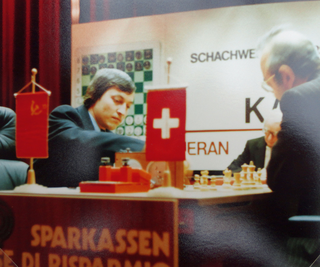The French Defence is a chess opening characterised by the moves:
The Nimzo-Indian Defence is a chess opening characterised by the moves:
The Pirc Defence is a chess opening characterised by the response of Black to 1.e4 with 1...d6 and 2...Nf6, followed by ...g6 and ...Bg7, while allowing White to establish a centre with pawns on d4 and e4. It is named after the Slovenian grandmaster Vasja Pirc.
In chess, a Wing Gambit is an opening in which White plays an early b4, deflecting an enemy pawn or bishop from c5 so as to regain control of d4, an important central square.
The Caro–Kann Defence is a chess opening characterised by the moves:
The Semi-Slav Defense is a variation of the Queen's Gambit Declined chess opening defined by the position reached after the moves:
Owen's Defence is an uncommon chess opening defined by the moves:

The World Chess Championship 2008 was a best-of-twelve-games match between the incumbent World Chess Champion, Viswanathan Anand, and the previous World Champion, Vladimir Kramnik. Kramnik had been granted a match after not winning the World Chess Championship 2007 tournament.

The World Chess Championship 1886 was the first official World Chess Championship match contested by Wilhelm Steinitz and Johannes Zukertort. The match took place in the United States from 11 January to 29 March, the first five games being played in New York City, the next four being played in St. Louis and the final eleven in New Orleans. The winner was the first player to achieve ten wins. Wilhelm Steinitz won the match 10–5, winning his tenth game in the twentieth game of the match. There were five draws.

The World Chess Championship 1889 was the second official World Chess Championship, and was between Wilhelm Steinitz and Mikhail Chigorin. It took place in Havana, Cuba. Steinitz defended his world title, and was the first of the two players to reach 10½. He won the match 10½-6½.

The third World Chess Championship was held in New York City from 9 December 1890 to 22 January 1891. Holder Wilhelm Steinitz narrowly defeated his Hungarian challenger, Isidor Gunsberg.

A World Chess Championship was played between challenger Max Euwe and title-holder Alexander Alekhine in various cities and towns in the Netherlands from 3 October to 16 December 1935. Euwe was the winner by overcoming a three-point deficit as late as the ninth game.

The 1978 World Chess Championship was played between Anatoly Karpov and Viktor Korchnoi in Baguio, Philippines, from July 18 to October 18, 1978. Karpov won, thereby retaining the title.

The 1981 World Chess Championship was played between Anatoly Karpov and Viktor Korchnoi in Merano, Italy from October 1 to November 19, 1981. Karpov won with six wins against two, with 10 draws. The two players had already played against each other in the World Chess Championship match 1978 in the Philippines, when Karpov also won.
The 1992 Fischer–Spassky match between former world chess champions Bobby Fischer and Boris Spassky was billed as a World Chess Championship, though it was an unofficial rematch of their 1972 World Championship match. Fischer won 10–5, with 15 draws.
The 20th season of the Top Chess Engine Championship began on 1 December 2020 and ended on 1 February 2021. The defending champion was Stockfish, which defeated Leela Chess Zero in the previous season's superfinal. The season 20 superfinal was a rematch between the same two engines. Stockfish once again came out ahead, winning by 6 games.





